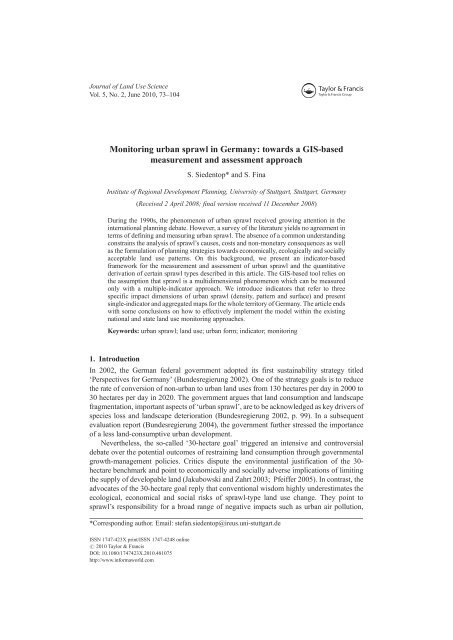PDF 20.134kB - TOBIAS-lib - Universität Tübingen
PDF 20.134kB - TOBIAS-lib - Universität Tübingen
PDF 20.134kB - TOBIAS-lib - Universität Tübingen
Sie wollen auch ein ePaper? Erhöhen Sie die Reichweite Ihrer Titel.
YUMPU macht aus Druck-PDFs automatisch weboptimierte ePaper, die Google liebt.
Journal of Land Use Science<br />
Vol. 5, No. 2, June 2010, 73–104<br />
Monitoring urban sprawl in Germany: towards a GIS-based<br />
measurement and assessment approach<br />
S. Siedentop* and S. Fina<br />
Institute of Regional Development Planning, University of Stuttgart, Stuttgart, Germany<br />
(Received 2 April 2008; final version received 11 December 2008)<br />
During the 1990s, the phenomenon of urban sprawl received growing attention in the<br />
international planning debate. However, a survey of the literature yields no agreement in<br />
terms of defining and measuring urban sprawl. The absence of a common understanding<br />
constrains the analysis of sprawl’s causes, costs and non-monetary consequences as well<br />
as the formulation of planning strategies towards economically, ecologically and socially<br />
acceptable land use patterns. On this background, we present an indicator-based<br />
framework for the measurement and assessment of urban sprawl and the quantitative<br />
derivation of certain sprawl types described in this article. The GIS-based tool relies on<br />
the assumption that sprawl is a multidimensional phenomenon which can be measured<br />
only with a multiple-indicator approach. We introduce indicators that refer to three<br />
specific impact dimensions of urban sprawl (density, pattern and surface) and present<br />
single-indicator and aggregated maps for the whole territory of Germany. The article ends<br />
with some conclusions on how to effectively implement the model within the existing<br />
national and state land use monitoring approaches.<br />
Keywords: urban sprawl; land use; urban form; indicator; monitoring<br />
1. Introduction<br />
In 2002, the German federal government adopted its first sustainability strategy titled<br />
‘Perspectives for Germany’ (Bundesregierung 2002). One of the strategy goals is to reduce<br />
the rate of conversion of non-urban to urban land uses from 130 hectares per day in 2000 to<br />
30 hectares per day in 2020. The government argues that land consumption and landscape<br />
fragmentation, important aspects of ‘urban sprawl’, are to be acknowledged as key drivers of<br />
species loss and landscape deterioration (Bundesregierung 2002, p. 99). In a subsequent<br />
evaluation report (Bundesregierung 2004), the government further stressed the importance<br />
of a less land-consumptive urban development.<br />
Nevertheless, the so-called ‘30-hectare goal’ triggered an intensive and controversial<br />
debate over the potential outcomes of restraining land consumption through governmental<br />
growth-management policies. Critics dispute the environmental justification of the 30hectare<br />
benchmark and point to economically and socially adverse implications of limiting<br />
the supply of developable land (Jakubowski and Zahrt 2003; Pfeiffer 2005). In contrast, the<br />
advocates of the 30-hectare goal reply that conventional wisdom highly underestimates the<br />
ecological, economical and social risks of sprawl-type land use change. They point to<br />
sprawl’s responsibility for a broad range of negative impacts such as urban air pollution,<br />
*Corresponding author. Email: stefan.siedentop@ireus.uni-stuttgart.de<br />
ISSN 1747-423X print/ISSN 1747-4248 online<br />
# 2010 Taylor & Francis<br />
DOI: 10.1080/1747423X.2010.481075<br />
http://www.informaworld.com

















